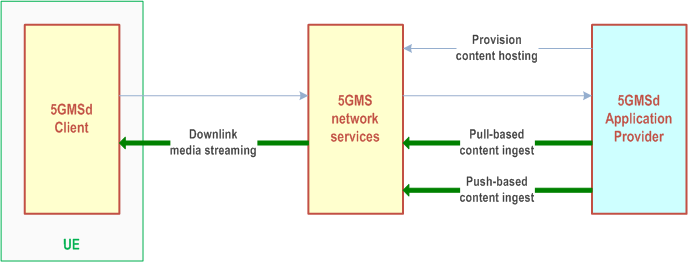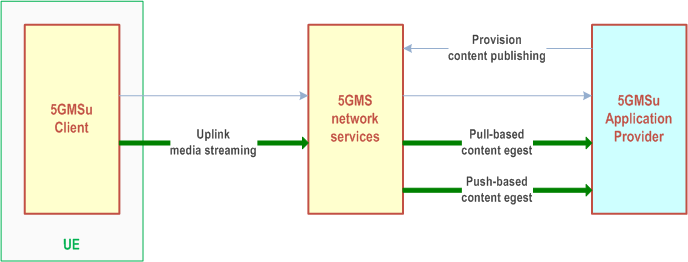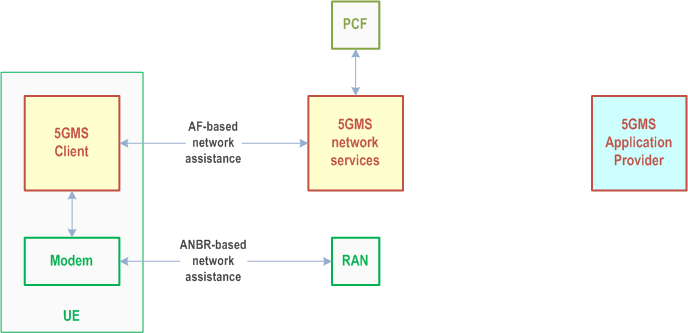Content for TS 26.501 Word version: 18.6.0
1…
4…
4.0.6…
4.1…
4.2…
4.2.2…
4.3…
4.4
4.5…
4.6…
4.7…
4.7.4…
4.8
4.9…
4.10…
5…
5.2…
5.2.4
5.2.5…
5.3…
5.3.2…
5.4…
5.5…
5.6…
5.7…
5.7.4…
5.7.8
5.8…
5.10…
5.10.5…
5.10.6…
5.11…
5.12…
5.12.4…
5.12.5…
6…
6.2…
6.2.2.2…
6.2.3…
6.3…
6.4…
6.8…
6.9…
6.9.5…
6.9.7
7…
8…
9…
A…
A.4…
A.8
A.9
A.10
A.11
A.12
A.13
A.14
A.15…
A.15.3…
B…
B.3
C…
C.3
C.4
C.5
D…
E…
4 Media Streaming architecture
4.0 Media Streaming features (informative)
4.0.1 Introduction
4.0.2 Content hosting
4.0.3 Content publishing
4.0.4 Content preparation
4.0.5 Network assistance
...
...
4 Media Streaming architecture p. 15
4.0 Media Streaming features (informative) p. 15
4.0.1 Introduction p. 15
This clause defines a set of high-level features for supporting enhanced media streaming in the 5G System. The functional architecture of this 5G Media Streaming (5GMS) System is defined in clause 4.1 and is further specialised for downlink media streaming (clause 4.2) and uplink media streaming (clause 4.3). Procedures for downlink media streaming are defined in clause 5 and those for uplink media streaming in clause 6.
In the context of the present document, streaming is defined as the delivery of time-continuous media as the predominant media. Streaming points to the fact that the media is predominantly sent only in a single direction and consumed as it is received. Additionally, the media content may be streamed as it is produced, referred to as live streaming. If content is streamed that is already produced, it is referred to as on-demand streaming. Streaming content may also be delivered in non-real time and stored for later consumption on demand.
References to Dynamic Adaptive Streaming over HTTP (MPEG-DASH) [29] in the present document apply equally to HTTP Live Streaming (HLS) RFC 8216 except where noted otherwise. The term Media Entry Point is used to refer generically to an MPEG-DASH Media Presentation Description (MPD) but may be taken to apply equally to alternative media presentation description formats such as an HLS master playlist, unless noted otherwise.
Table 4.0.1-1 lists the principal features of the 5GMS architecture along with cross-references to relevant clauses defining its functions and procedures.
| Feature | Feature description clause | Procedure definition clause(s) | |
|---|---|---|---|
| Downlink media streaming | Uplink media streaming | ||
| Content hosting | 4.0.2 | 5.4 | Not applicable |
| Content publishing | 4.0.3 | Not applicable | 6.2.3 |
| Content preparation | 4.0.4 | Not defined | Not defined |
| Network assistance | 4.0.5 | 5.9 | 6.5, 6.7 |
| Dynamic policies | 4.0.6 | 5.8, 5.7.6 | 6.9 |
| Remote control | 4.0.7 | Not applicable | 6.6 |
| Consumption reporting | 4.0.8 | 5.6 | Not applicable |
| QoE metrics reporting | 4.0.9 | 5.5 | Not applicable |
| Edge processing | 4.0.10 | 8 | |
| eMBMS delivery | 4.0.11 | 5.10 | Not applicable |
| Data collection, reporting and exposure | 4.0.12 | 5.11 | 6.8 |
| Service URL handling | 4.0.13 | 9, 5.10.7 | 9 |
The following clauses introduce these features in terms of network-side components ("5GMS network services") and a UE-side client component referred to variously as the 5GMSd Client (for downlink media streaming), 5GMSu Client (for uplink media streaming), or simply 5GMS Client (in the case of features applicable to either downlink media streaming or uplink media streaming).
4.0.2 Content hosting p. 16
The content hosting feature is applicable to downlink media streaming only. It provides a service equivalent to a Content Delivery Network (CDN) deployed inside or outside the Trusted DN. High-level procedures for this feature are defined in clause 5.4.

When a 5GMSd Application Provider has provisioned the content hosting feature for downlink media streaming:
- Media content is either retrieved by a network-side component of the 5GMS System from a media origin at the 5GMSd Application Provider (pull-based content ingest) or else it is published to a network-side component of the the 5GMS System by the 5GMSd Application Provider (push-based content ingest).
- The network-side component of the 5GMS System may cache this content for a configurable period of time.
- Network-side components of the 5GMS System may manipulate the content according to rules provisioned in Content Preparation Templates (see clause 4.0.4).
- The 5GMSd Client in the UE subsequently retrieves the (possibly manipulated) media content as part of a downlink media streaming session. The security of the content served to the 5GMSd Client by network-side components of the 5GMS System may be guaranteed by a provisioned Server Certificate.
4.0.3 Content publishing p. 16
The content publication feature is applicable to uplink media streaming only. High-level procedures for this feature are defined in clause 6.2.3.

Figure 4.0.3-1: High-level arrangement for content publishing feature
(⇒ copy of original 3GPP image)
(⇒ copy of original 3GPP image)
When a 5GMSu Application Provider has provisioned the content publishing feature for uplink media streaming:
- Media content is published by the 5GMSu Client in the UE to a network-side component of the 5GMS System as part of an uplink media streaming session. The security of the content published to the 5GMS System may be guaranteed by a provisioned Server Certificate.
- The network-side component of the 5GMS System may cache this content for a configurable period of time.
- Network-side components of the 5GMS System may manipulate the content according to rules provisioned in Content Preparation Templaes (see clause 4.0.4).
- A network-side component of the 5GMS System makes the media content available for retrieval by the 5GMSu Application Provider (pull-based content egest) or publishes it directly to the 5GMSu Application Provider (push-based content egest).
4.0.4 Content preparation p. 17
The content preparation feature is applicable to both downlink media streaming (where is is provisioned as part of the content hosting feature introduced in clause 4.0.2) and uplink media streaming (where is is provisioned as part of the content publishing feature introduced in clause 4.0.3). The content preparation feature enables a 5GMS Application Provider to specify content manipulation by network-side components of the 5GMS System according to provisioned Content Preparation Templates.
When a 5GMSd Application Provider has provisioned the content preparation feature for downlink media streaming:
- Network-side components of the 5GMS System may manipulate ingested media content and may cache the manipulated content prior to serving it to the 5GMSd Client in the UE.
- Network-side components of the 5GMS System may manipulate the media content ingested from the 5GMSu Client in the UE and may cache the manipulated content prior to egesting it to the 5GMSu Application Provider.
4.0.5 Network assistance p. 18
The network assistance feature is applicable to both downlink media streaming and uplink media streaming. It enables the 5GMS Client in the UE to interrogate or manipulate the network Quality of Service for an ongoing media streaming session.
High-level procedures for this feature are defined in clause 5.9 (downlink media streaming) and in clauses 6.1, 6.5 and 6.7 (uplink media streaming). The network assistance feature is not explicitly provisioned by the 5GMS Application Provider. It is either available for a particular media streaming session or not, depending on system pre-configuration and/or policy.
Two mechanisms for obtaining network assistance are defined in the present document: one based on interactions with the PCF via network-based components of the 5GMS System (AF-based network assistance), the other based on ANBR signalling interactions between the UE modem and the RAN (ANBR-based network assistance).

Figure 4.0.5-1: High-level arrangement for network assistance feature
(⇒ copy of original 3GPP image)
(⇒ copy of original 3GPP image)
The following network assistance sub-features are defined in this release for both the AF-based and ANBR-based mechanisms:
- Bit rate recommendation (or throughput estimation): The 5GMS Client requests an estimate from a network-side component of the 5GMS System of the bit rate that can currently be offered by a media streaming session. The network-side component interrogates the PCF on behalf of the 5GMS Client to obtain this information about the PDU session corresponding to the media streaming session. The 5GMS Client uses this information to adjust its own streaming bit rate to fit within the Quality of Service (QoS) envelope that the network is able to offer, for example by switching to a different representation listed in its Media Entry Point, or by adjusting the encoding bit rate for uplink streaming to fit within this bit rate budget. The media streaming Quality of Experience (QoE) is more stable and consistent as a consequence.
- Delivery boost: The 5GMS Client speculatively requests a temporary boost to the bit rate of a media streaming session from a network-side component of the 5GMS System. The network-side component requests a modification to the PDU session corresponding to the media streaming session from the PCF on behalf of the 5GMS Client. If there is sufficient spare network capacity to accommodate the requested bit rate, it is granted by the 5GMS System on a temporary basis. The 5GMS Client uses this temporary boost to speed up media streaming data transfer, for example to replenish a depleted downlink streaming buffer or to complete a download/upload faster than would otherwise be possible.